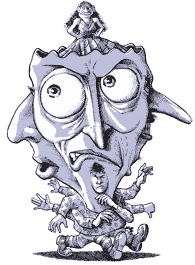I can’t resist quoting Julian Sanchez at length:
As regular readers know, I’m fond of invoking a thought experiment from philosopher Derek Parfit called “The Harmless Torturers.” Parfit imagines one scenario in which 10,000 torturers each torture one of 10,000 victims using an electrocution machine. Each torturer clearly inflicts terrible agony on an individual victim. In Parfit’s second scenario, each torturer’s machine is configured so as to deliver one-ten-thousandth of the same voltage—a quantity so small as to be utterly imperceptible to the victim by itself—to all of the victims who were individually electrified in the first scenario. In the aggregate, the torturers inflict exactly the same amount of pain on exactly the same number of people. But in this second scenario, each torturer can—with some justice—claim that his actions are “harmless.” Each, in other words, can claim: “If I stayed home, there is not one of those 10,000 victims who would feel any difference.”
As applied to physical torture, the scenario is fanciful. As applied to psychological torture, it describes the norm. Only a few really horrid people commit themselves to relentlessly harassing and abusing a single individual. But many teens—and not a few nominal adults—will make a handful of snarky and cutting remarks to numerous different individuals over the course of an ordinary day. It would often be overblown to characterize any particular remark as bullying: In isolation, all but the most fragile of us would shrug it off. In the aggregate, they may be intolerable to even the most self-assured.
One reason “cyberbullying” may present special problems is that the Internet and social networks dramatically increase the realistic number of people who can pile on a single victim in a short period of time. Each aggressor might rationalize their own part in the distributed bullying as just one or two comments, though the victim perceives an overwhelming assault when these are all combined. For an analogy in the physical world, we can look to street harassment, which is enabled by the high volume of anonymous, brief public interactions characteristic of urban environments.
I’d actually say that much of real-life bullying in schools uses a similar dynamic; like urban streets, schools are a place where people who might make comments are unnaturally dense, and you just have no choice but to be walking by them lots of time every day.
Another issue is prejudice. For many people, the bigotry they encounter in their day to day life is small, difficult to complain about, and often ambiguous. (I’ve posted about this before.) A study has found that subtle, ambiguous racism is actually more mentally difficult to deal with than blatant racism.
And this, too, accumulates. It’s easy to dismiss one rude clerk, one sneering stranger, one odd look. But the more it happens, it’s tiring to have to wonder, each time someone treats you with inexplicable rudeness, is it bigotry?



That’s an excellent post, Amp, thank you. It reminds me why it’s so important to be sure to be unceasing in my vigilance about my own privilege, and why it’s so important to do the little moves forward in social justice: the small changes in language, the small changes in concepts and institutions, that each add up to a much greater whole.
The principle works in both directions, y’see. This is what we over at Shakesville call the teaspoon approach.
I like that quote. I’ve long wanted to spend a week writing down every time somebody in my presence said something like “if I eat this I will get fat” or “watch out–this is so fattening,” or implied that being fat and being unfit are the same thing, or implied all fat people are lazy, or made some joke about everybody being obese in 50 years, or or or…
I remember reading an article somewhere that made this point as: if you’re a white person and you see someone claiming something is racist, you should understand that, on average, they’re likely to be correct–even if this particular instance has another explanation. (I do also enjoy the people who say–as you mention in your earlier article–that it’s the clothing style, not the race, that makes a difference, as if perceptions of clothing styles are completely divorced from race!)
*my particular favorite this week: the throwaway line in an article on the value of practicing evacuations from skyscrapers that said “and then the obese will learn they’re slowing everybody else down!”
There’s no simple solution to that sort of collective problem.
If the victim responds at the level of the offender’s individual conduct, the response isn’t likely to get much play: the individual conduct simply isn’t that bad, and may be well within the grounds of acceptable social discourse. the victim gets poorly served.
If the victim responds at the level of the collective harm to the victim, the response is (from the perspective of the offender) way overblown. They’re accused of burning someone alive, when all they did is drop a little match near their feet. The offender gets overpunished.
It’s classic Type I and Type II error and (as things stand now) a classic question: if society has to choose between overpunishment of offenders and underassistance to victims, which one wins?
And IMO the answer to that depends on whether you view society’s role primarily as limiting overreach, or primarily as supplying benefits. Right now society limits overreach: in criminality, for example, we prioritize “don’t convict the innocent” over “convict the guilty.” So in the collective action problem, we don’t usually like to overpunish the offenders.
The move towards victim protection is inherently a move towards a more militant and big brother-ish society, while the move towards free speech and free action is inherently going to screw this type of victim.
Another detriment is that it causes the recipient of such bullying to then over-predict it or find it in cases where it actually doesn’t exist–compounding the problem again and again as it then adds to the times it really does exist to become an even more crippling assault.
Or, sometimes it causes the person to try to play it down even when it exists–sometimes causing them to walk into more dangerous situations than they normally would have tolerated.
The drip drip drip makes it difficult to find the appropriate psychological/self-protection balance.
I am discouraged by this discussion, which assumes that we are all are behaving without kindness or courtesy to each other, and that this might be OK if it’s not too gross.
It is not OK to behave unkindly towards anyone, even thought it’s only a “little” unkind. It is not OK to bully anyone in “minor” ways. (Let alone major ways.)
Neither being a “weird stranger” nor being an “odd looker” nor being “rude” in any capacity is OK. I hesitate to make a religious reference, but whatever happened to the “golden rule” (which recurs in every religion on earth, by the way?)? So what if your violation is not “major,” it’s still wrong, yes?
As for children, when I was a kid both parents and the school took responsibility here, and a bully was mercilessly beaten up (psychologically) by the Powers That Be until he or she stopped doing it. As a beaten-up 10-year-old bully I can attest to that from sad personal experience.
Where the heck are the adults in this situation???
I’m not sure if you intend this to be as sweeping as you imply. But the problem is that this involves a judgment of what “unkindly” means. if you’ve got two different people, you’ve probably got two different definitions. Just because I claim that your disagreement is unkind, you presumably wouldn’t stop disagreeing (and rightly so.)
Also, people are sometimes unkind, at least a little. We just.. are. Everyone. And while it’s not precisely ideal, it’s so common and normal that branding it Not Okay seems sort of pointless. if the only properly behaved person is the dalai lama, does that help at all?
@Susan –
First, like G&W said, people aren’t perfect – and expecting perfection from people isn’t a good way to live your life. It’s one thing to say we should aspire to be universally kind – I certainly agree to that – but it’s another to not recognize that it’s not a goal that’s easy, or even necessarily possible, to achieve.
Second, I don’t think your interpretation of this discussion is correct. It is not about assuming that people are unkind. It’s about making people more aware about the fact that even if they don’t view themselves as unkind, they may be. The golden rule is a good first step but it’s only a first step – treating others as I want to be treated may not be a kindness, if they do not want to be treated that way. This was a lesson I learned quite powerfully when I moved from Israel to the US; I was brought up in a culture where you show respect to someone by being very direct with them, and I found myself in a culture where directness is often interpreted as a sign of aggression. Knowing this – knowing that it’s not my intentions, but how my interlocuters interpret my actions, that matters was very useful when I relocated again, to the UK, and had to learn yet another set of cultural expectations.